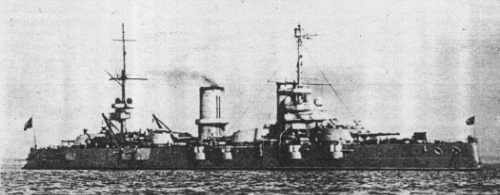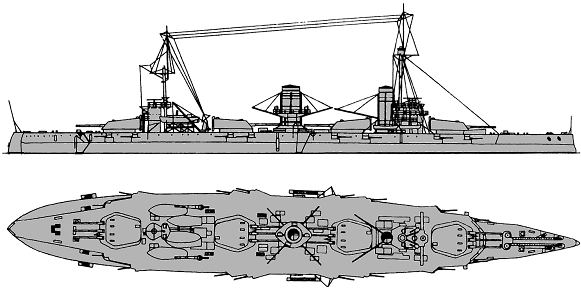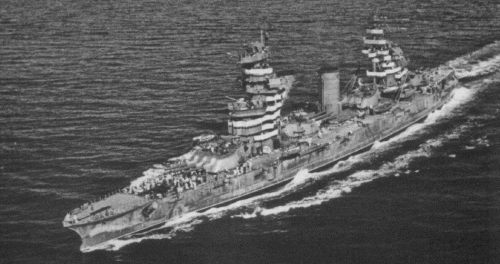
NAVYPEDIA
 Support the project with paypal
Support the project with paypal
Photo

Marat 1923
Ships
| Name | No | Yard No | Builder | Laid down | Launched | Comp | Fate |
|---|---|---|---|---|---|---|---|
| Гангут [Gangut], 6.1925- Октябрьская Революция [Oktyabr'skaya Revoliutsiya] | New Admiralty, St. Petersburg | 16.6.1909 | 7.10.1911 | 4.11.1914 | stricken 2.1956 | ||
| Севастополь [Sevastopol], 3.1921- Парижская коммуна [Parizhskaya Kommuna], 5.1943- Севастополь [Sevastopol] | Baltic Wks, St. Petersburg | 16.6.1909 | 29.6.1911 | 17.11.1914 | stricken 2.1956 | ||
| Полтава [Poltava] | New Admiralty, St. Petersburg | 16.6.1909 | 10.7.1911 | 17.12.1914 | fire 25.11.1919, never repaired | ||
| Петропавловск [Petropavlovsk], 3.1921- Марат [Marat], 5.1943- Петропавловск [Petropavlovsk], 11.1950- Волхов [Volkhov] | Baltic Wks, St. Petersburg | 16.6.1909 | 9.9.1911 | 2.1.1915 | badly damaged 23.9.1941, used as non-self-propelled floating battery, hulk 9.1951 |
Technical data
| Displacement normal, t | 23288 |
|---|---|
| Displacement full, t | 26900 |
| Length, m | 180.0 wl 181.2 oa |
| Breadth, m | 26.9 |
| Draught, m | 8.40 mean 9.20 max full load |
| No of shafts | 4 |
| Machinery | 4 Parsons steam turbines, 25 Yarrow boilers |
| Power, h. p. | 42000 |
| Max speed, kts | 23 |
| Fuel, t | oil 1170 + coal 3000 |
| Endurance, nm(kts) | 1500(14) |
| Armour, mm | belt: 225 - 100, upper belt: 125 - 75, bulkheads: 125 - 100, upper deck: 38, medium deck: 25, main deck: 12 with 50-mm slopes, turrets: 305 - 203, barbettes: 150 - 75, casemates: 125, CT: 250 - 120 |
| Armament | 4 x 3 - 305/50, 16 x 1 - 120/49 Vickers, 4 x 1 - 47/40 Hotchkiss, 4 - 450 TT (sub, beam) |
| Complement | 1140 |
Standard scale images

Sevastopol 1945

Parizhskaya Kommuna 1938

Oktyabrskaya Revolyutsiya 1939

Sevastopol 1914

Marat 1941

Parizhskaya Kommuna 1941
Graphics
Project history
The first Russian dreadnoughts, designed using experience of the Russian-Japanese war that has predetermined a number of unusual features of the ships of this class. The basic requirement was brought together to providing of the maximum protection against HE shells therefore the armour covered all freeboard, but its thickness has appeared less, than at battleships of other countries. Main guns placing became the second characteristic line of Russian dreadnoughts: in four triple turrets in regular intervals distributed on a length of the ship: such arrangement in Russian Naval Staff considered optimum for squadron battle. The design assignment has been formulated by the end of 1907 then the international competition was declared. The design of the Baltic Works became the winner, and under it in 1909 4 ships were laid down: Sevastopol and Petropavlovsk on Baltic Works, Gangut and Poltava at New Admiralty. Battleships of Sevastopol class had flush lowboard hull with an icebreaking stem and a minimum of superstructures. 5.1m-high main belt cocered all the hull length. Amidships (between end barbettes) its thickness was 225 mm, at ship ends 125mm, and at a stern frame 100mm. The upper belt above placed with thickness of 125mm amidships and 75mm in a bow; only upper part of the board aft from aft barbette was unprotected. The main belt was closed by 100-125mm transverse bulkheads. Armour decks was three: 38mm upper, adjoining to an upper edge of the main belt, 25mm medium and 12mm low with 50mm slopes. Turrets had 203mm faces and sides, 350mm rears and 76mm roofs. Machinery consisted from 10 Parsons turbines, placing in three engine rooms and working on 4 shafts. At 32000hp ships should make 21.75kts, and when forced at 42000hp 23kts. Building of the ships was slow, and they were completed already after the First World War beginning in which practically did not participate. Gangut and Poltava in March, 1918 were stricken from the fleet list and were put on long-term storage. Gangut was returned to the fleet in 1925. On Poltava (renamed 7.1.1926 Frunze) in 1919 there was a fire, the ship has not been repaired after it and scrapped in 1941. Parizhskaya Kommuna in 1929 was transferred to Black sea.
In 1928-1938 all three survived battleships have serially passed modernizations in which course have received more developed superstructures with fore funnel gracefully curved back, and also superstructure for the bow for seaworthiness improvement. Thus the type and the form of a foremast and a superstructures on all ships in this or that slightly differed. Also turbines were completely changed by the new ones intended for Izmail class battlecruisers, and also new oil-burning boilers were fitted. These measures have allowed to keep speed at former level, despite the increased displacement. On trials Marat has shown 23.8kts; Oktyabrskaya Revolyutsiya 22.87kts. Parizhskaya Kommuna has received the strengthened deck armour that has negatively affected a stability. Therefore during the second stage of modernization (1939-1941) ship received the bulges which have increased a hull beam on 5.6 m, their 50mm sides gave additional vertical side protection. Underwater protection depth was thus increased to 6.1m. Thus, her original sisterships to the Great Patriotic War beginning had a number of significant differences.
Ship protection
Complete main belt had 5.1m height and 225mm thickness at 116.5m length between end barbettes, its thickness decreased to 125mm at ship ends (100mm at short part near stern). Upper belt was 2.3m high and had 125mm thickness between end barbettes and 75mm fwd from fwd barbette. Both belts were closed by 125-100mm bulkheads abreast end barbettes. Upper 38mm flat deck connected with upper edge of upper edge, medium deck at level between upper and main belts had 25mm thickness. 12mm main deck connected with lower edge of main belt by 50mm slopes. Turrets had 203mm faces and sides, 305mm rears and 76mm roofs. Fwd CT had 250mm sides and 120mm roof, aft CT had 120mm vertical and horizontal protection.
Modernizations
1916 - 1917, Gangut, Petropavlovsk: - 4 x 1 - 47/40; + 2 x 1 - 63/36 Obukhov Wks AA, 1 x 1 - 47/40 Hotchkiss AA
1916 - 1917, Sevastopol, Poltava: - 4 x 1 - 47/40; + 2 x 1 - 75/48 Canet AA, 1 x 1 - 40/39 Vickers AA
1920 - 1922, all: AA guns were replaced by 6 x 1 - 76/28 8K
(10/1928 - 5.1929), Parizhskaya Kommuna: received a clipper bow (length oa was 184.9 m)
1930, Parizhskaya Kommuna: + catapult (on roof of turret No 3), 1 seaplane (Ju 20)
(Autumn 1928 - 5.1931), Marat: boilers were rebuilt for burning oil (1950t max stowage), 3 boilers were removed (22 boilers remained), main engines were overhauled (61100shp, 23.8kts), clipper bow was built (length oa was 184.9m), 75mm part of upper belt between stem and barbette No 1 was dismantled, 100mm bulkhead was installed between medium and forecastle decks at frame No14. Fore mast was rebuilt, fore funnel was curved. Displacement was 24230 / 26700t.
(9/1931 - 8.1934), Oktyabrskaya Revolyutsiya: all old boilers were replaced by 12 new oil-burning ones, main engines were overhauled (60600shp, 22.5kts, max 2018t of oil), new clipper bow increased length oa to 184.9m, 75mm part of upper belt between stem and barbette No 1 was dismantled, 50mm bulkhead was installed between medium and forecastle decks at frame No14. Fore mast was rebuilt, fore funnel was curved. + 4 x 1 - 45/44 21K, 1 seaplane (without catapult). Displacement was 24234 / 26692t.
1937, Oktyabrskaya Revolyutsiya: - 4 x 1 - 45/44
(11/1933 - 1.1938), Parizhskaya Kommuna: all old boilers were replaced by 12 new oil-burning ones, main engines were overhauled (60600shp, 22.5kts, max 2115t of oil), new clipper bow increased length oa to 184.9m, 75mm part of upper belt between stem and barbette No 1 was dismantled, 50mm bulkhead was installed between medium and forecastle decks at frame No14. 25mm medium deck between end barbettes was replaced by 75mm one, turret roofs armour thickness was increased from 76 to 152mm. Fore mast was rebuilt, fore funnel was curved. Maximal angle of main guns elevation was increased to 40°. - 6 x 1 - 76/28, 4 - 450 TT; + 6 x 1 - 76/52 34K, 6 x 1 - 45/44 21K, 12 x 1 - 12.7/79, 2 seaplanes (without catapult)
1939, Marat, Oktyabrskaya Revolyutsiya: turret roofs armour thickness was increased from 76 to 152mm.
1940, Marat: - 2 x 1 - 120/49, 6 x 1 - 76/28; + 2 x 2 - 76/52 81K, 6 x 1 - 76/52 34K, 6 x 1 - 37/63 70K, 13 x 1 - 12.7/79
1940, Oktyabrskaya Revolyutsiya: - 6 x 1 - 76/28; + 6 x 1 - 76/52 34K
(11/1939 - 2.1941), Parizhskaya Kommuna: bulges were fitted, these bulges were 144m long, extended to upper deck and had 50mm outer plating (so maximal side protection was 275mm), breadth was increased to 32.5m. Underwater protection was 6.1m deep and could resist exploding of 170kg TNT. Displacement rose from 25070/27190 to 27060 / 30395t.
4/1941, Parizhskaya Kommuna: - 6 x 1 - 45/44, 4 x 1 - 12.7/79; + 12 x 1 - 37/63 70K
Spring 1941, Oktyabrskaya Revolyutsiya: - 2 x 1 - 120/49; + 2 x 2 - 76/52 81K, 12 x 1 - 37/63 70K, 2 x 4 - 12.7/62, 2 x 2 - 12.7/79, 4 x 1 - 12.7/79
8/1941, Oktyabrskaya Revolyutsiya: - 4 x 1 -120/49
3/1942, Oktyabrskaya Revolyutsiya: + 4 x 1 - 37/63 70K
4/1942, Oktyabrskaya Revolyutsiya: + 1 x 2 - 76/52 81K
9/1942, Oktyabrskaya Revolyutsiya: + 1 x 4 - 37/63 46K
(4 - 7.1942), Parizhskaya Kommuna: + 4 x 1 - 37/63 70K
1944, Oktyabrskaya Revolyutsiya: - 4 - 450 TT
1944 - 1945, Oktyabrskaya Revolyutsiya: + SG-1, type 281, type 284 radars
8/1944, Sevastopol: + type 281 radar.
1/1946, Oktyabrskaya Revolyutsiya: 4 x 3 - 305/52, 10 x 1 - 120/50 Vickers, 3 x 2 - 76/55 81K, 6 x 1 - 76/55 34K, 1 x 4 - 37/73 46K, 16 x 1 - 37/73 70K, 2 x 2 - 12.7/79, 4 x 1 - 12.7/79, 2 x 4 - 12.7/62, 1 seaplane; SG-1, type 281, type 284 radars
1/1946, Sevastopol: 4 x 3 - 305/52, 16 x 1 - 120/50 Vickers, 6 x 1 - 76/55 34K, 16 x 1 - 37/73 70K, 8 x 1 - 12.7/79, 2 seaplanes, type 281 radar
Naval service
Poltava was badly damaged by fire and was never repaired but was renamed Фрунзе [Frunze] in January 1926.
Marat 23.9.1941 was hard damaged by German diving bombers: the fore end, including a superstructure, was broken off. Fore part of the ship ran aground but after part remained afloat, later cut away from fore part and used as floating battery. Ship was not repaired and further was used as "floating" non-self-propelled (and non-towed!) battery though formally she was not stricken and 31.5.1943 even was renamed Petropavlovsk. In 1942 she lost most part of 120mm guns and 2 twin 76mm AA guns. To the early 1944 she had 19500t displacement, 127m length, complement 351 and was armed with 3 triple 305mm/52, 3 single 76mm/55, 4 single 45mm/46, 5 single 37mm/67 guns, 8 single 12.7mm MGs. 28.11.1950 Petropavlovsk was reclassified as training hulk and renamed in Volkhov; she was broken up in 1953. 24.7.1954 both survived battleships were re-rated as TSs and 17.2.1956 stricken.
 HOME
HOME FIGHTING SHIPS OF THE WORLD
FIGHTING SHIPS OF THE WORLD RUSSIA / USSR
RUSSIA / USSR CAPITAL SHIPS AND MONITORS
CAPITAL SHIPS AND MONITORS SEVASTOPOL battleships (1914-1915)
SEVASTOPOL battleships (1914-1915)


